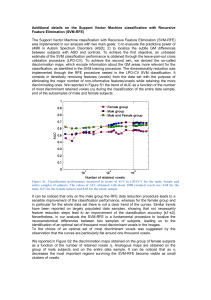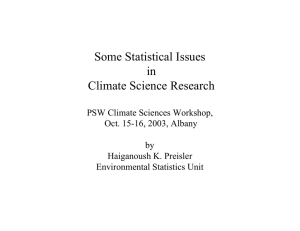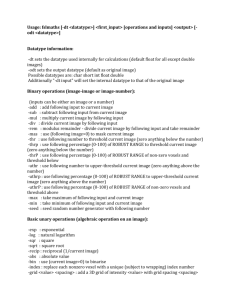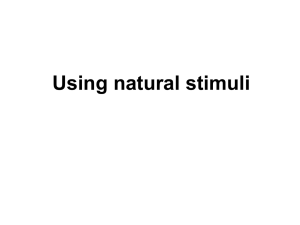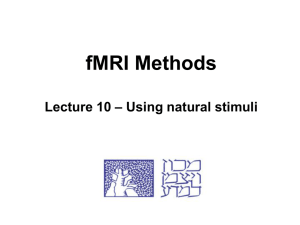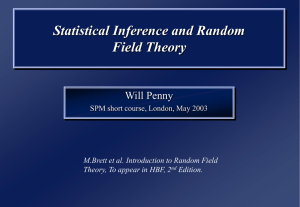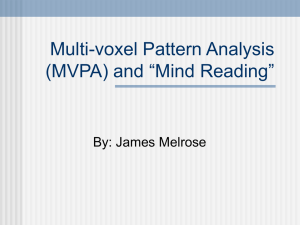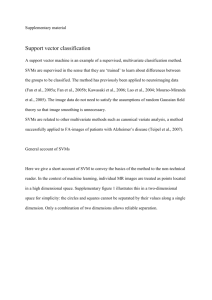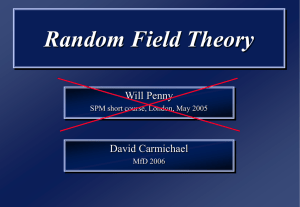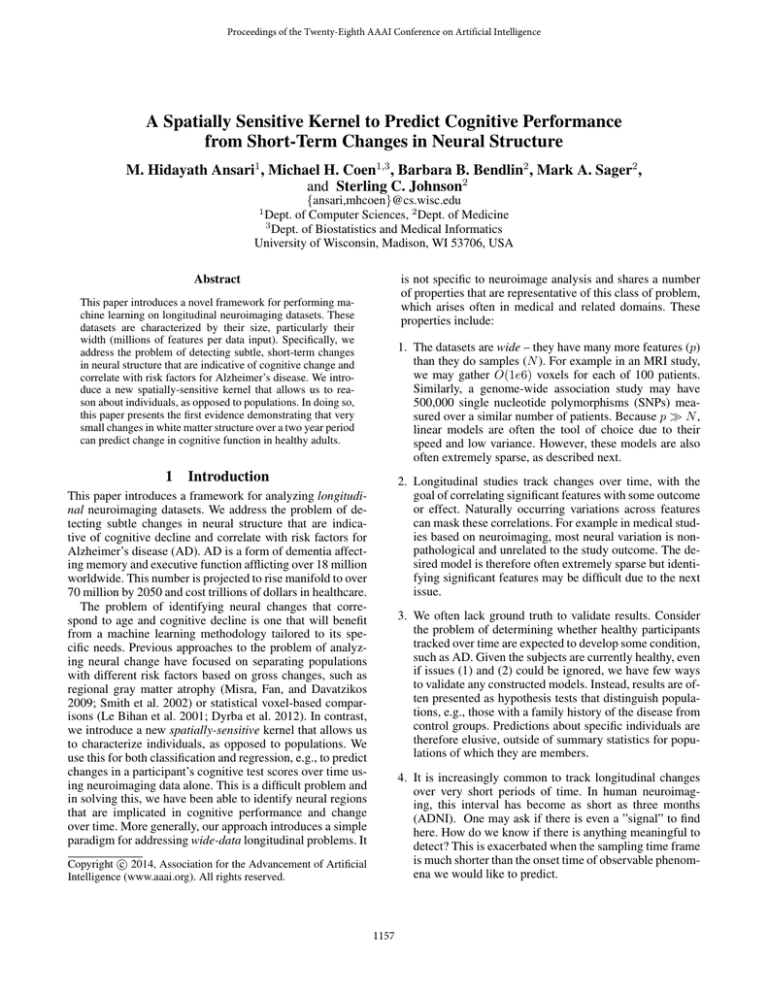
Proceedings of the Twenty-Eighth AAAI Conference on Artificial Intelligence
A Spatially Sensitive Kernel to Predict Cognitive Performance
from Short-Term Changes in Neural Structure
M. Hidayath Ansari1 , Michael H. Coen1,3 , Barbara B. Bendlin2 , Mark A. Sager2 ,
and Sterling C. Johnson2
{ansari,mhcoen}@cs.wisc.edu
Dept. of Computer Sciences, 2 Dept. of Medicine
3
Dept. of Biostatistics and Medical Informatics
University of Wisconsin, Madison, WI 53706, USA
1
Abstract
is not specific to neuroimage analysis and shares a number
of properties that are representative of this class of problem,
which arises often in medical and related domains. These
properties include:
This paper introduces a novel framework for performing machine learning on longitudinal neuroimaging datasets. These
datasets are characterized by their size, particularly their
width (millions of features per data input). Specifically, we
address the problem of detecting subtle, short-term changes
in neural structure that are indicative of cognitive change and
correlate with risk factors for Alzheimer’s disease. We introduce a new spatially-sensitive kernel that allows us to reason about individuals, as opposed to populations. In doing so,
this paper presents the first evidence demonstrating that very
small changes in white matter structure over a two year period
can predict change in cognitive function in healthy adults.
1
1. The datasets are wide – they have many more features (p)
than they do samples (N ). For example in an MRI study,
we may gather O(1e6) voxels for each of 100 patients.
Similarly, a genome-wide association study may have
500,000 single nucleotide polymorphisms (SNPs) measured over a similar number of patients. Because p N ,
linear models are often the tool of choice due to their
speed and low variance. However, these models are also
often extremely sparse, as described next.
Introduction
2. Longitudinal studies track changes over time, with the
goal of correlating significant features with some outcome
or effect. Naturally occurring variations across features
can mask these correlations. For example in medical studies based on neuroimaging, most neural variation is nonpathological and unrelated to the study outcome. The desired model is therefore often extremely sparse but identifying significant features may be difficult due to the next
issue.
This paper introduces a framework for analyzing longitudinal neuroimaging datasets. We address the problem of detecting subtle changes in neural structure that are indicative of cognitive decline and correlate with risk factors for
Alzheimer’s disease (AD). AD is a form of dementia affecting memory and executive function afflicting over 18 million
worldwide. This number is projected to rise manifold to over
70 million by 2050 and cost trillions of dollars in healthcare.
The problem of identifying neural changes that correspond to age and cognitive decline is one that will benefit
from a machine learning methodology tailored to its specific needs. Previous approaches to the problem of analyzing neural change have focused on separating populations
with different risk factors based on gross changes, such as
regional gray matter atrophy (Misra, Fan, and Davatzikos
2009; Smith et al. 2002) or statistical voxel-based comparisons (Le Bihan et al. 2001; Dyrba et al. 2012). In contrast,
we introduce a new spatially-sensitive kernel that allows us
to characterize individuals, as opposed to populations. We
use this for both classification and regression, e.g., to predict
changes in a participant’s cognitive test scores over time using neuroimaging data alone. This is a difficult problem and
in solving this, we have been able to identify neural regions
that are implicated in cognitive performance and change
over time. More generally, our approach introduces a simple
paradigm for addressing wide-data longitudinal problems. It
3. We often lack ground truth to validate results. Consider
the problem of determining whether healthy participants
tracked over time are expected to develop some condition,
such as AD. Given the subjects are currently healthy, even
if issues (1) and (2) could be ignored, we have few ways
to validate any constructed models. Instead, results are often presented as hypothesis tests that distinguish populations, e.g., those with a family history of the disease from
control groups. Predictions about specific individuals are
therefore elusive, outside of summary statistics for populations of which they are members.
4. It is increasingly common to track longitudinal changes
over very short periods of time. In human neuroimaging, this interval has become as short as three months
(ADNI). One may ask if there is even a ”signal” to find
here. How do we know if there is anything meaningful to
detect? This is exacerbated when the sampling time frame
is much shorter than the onset time of observable phenomena we would like to predict.
c 2014, Association for the Advancement of Artificial
Copyright Intelligence (www.aaai.org). All rights reserved.
1157
1.1
Framework
based on the interference trial from the Stroop Test (Trenerry et al. 1989), and Trail Making Test A and B (Reitan and
Wolfson 2009).
Our approach will begin with a ”simple” classification problem. For longitudinal data, one instance of ground truth is
the chronological order in which the datasets were collected.
Thus, a natural question is: can we determine this order
for a given individual? Solving this problem allows us to
identify and rank the most temporally significant (longitudinally) and consistent (cross-sectionally) voxels in our data.
We hypothesize that these voxels correlate with other temporally sensitive data, such as cognitive test scores. In confirming this hypothesis using the novel computational methods in Section 3 for the experiments in Section 4, we present
the first evidence demonstrating that very small changes in
white matter structure over a two year period can predict
change in cognitive function in healthy adults.
2
Preprocessing Raw scan data was processed and nonlinearly registered to a template image in standard MNI152
space using Tract-Based Spatial Statistics (TBSS) (Smith et
al. 2006). Each scan underwent identical preprocessing.
Using the white matter atlas from the Johns’ Hopkins
University DTI research group (Oishi et al. 2008), we extracted the voxels corresponding to the corpus callosum, superior longitudinal fasciculus, fornix, and cingulum bundle.
These regions were chosen based on their vulnerability to
Alzheimer’s disease (Di Paola et al. 2010; Benitez et al.
2014; Canu et al. 2013). The sizes of these regions range
from hundreds to over 20,000 voxels.
Figure 1 illustrates the location and shape of the corpus
callosum and details its splenium (back), which is a region
known to show significant changes both is healthy aging and
AD.
Background and Data
The analysis in this paper focuses on the white matter (WM)
regions of the brain. Much previous research on Alzheimer’s
disease has focused on gray matter; white matter has historically been regarded as less relevant to cognition. In recent years, however, the role of white matter in the transfer of information has attracted vigorous interest (Ziegler
et al. 2010). Data examined here come from the Merit220
and PREDICT cohorts provided by the Wisconsin Registry
for Alzheimer’s Prevention (Sager, Hermann, and La Rue
2005). Longitudinal imaging and cognitive testing data were
available for 75 subjects, who were healthy and middle-aged
(ranging from ages 45 to 70). All tested cognitively normal on neuropsychological assays. A significant percentage
(78%) of subjects showed one or more risk factors for AD.
Imaging data consisted of measurements of white matter
microstructure obtained through diffusion tensor magnetic
resonance imaging (DT-MRI, or DTI). Specifically, we use a
summary measure at each voxel called fractional anisotropy
(FA). FA is a scalar measure of the directional coherence
of water diffusion that reflects tissue microstructure, and
is particularly sensitive to white matter organization in the
brain (Basser and Pierpaoli 1996).
Each subject additionally provided extensive demographic information. The subjects were also genotyped to
determine the presence of the apolipoprotein E (APOE) 4
allele, which is the strongest genetic risk factor for late onset Alzheimer’s disease and is associated with earlier age of
onset compared to other forms (Corder et al. 1993). In the
experiment detailed in Section 4.2 we examine whether the
presence or absence of this allele leads to a difference in the
way WM changes over time.
2.1
3
A Point Set Approach
In many classification problems, data are often abstracted
into a representation, e.g., a vector, that fails to retain their
spatial information. This is common with many methods in
machine learning. However, given the inherent spatial nature
of the voxel data, incorporating the voxel locations into our
analysis seemed reasonable. This view has received much
scrutiny in clustering (Coen, Ansari, and Fillmore 2010),
where set theoretic measures of similarity cannot capture
subtle changes in the spatial distribution of data. Rather
than serialize the voxels of a brain or region into one vector and lose their locations, we represent them as a point set
B = (V, W ) where V ⊂ R3 is the set of positions of the
voxels, W ⊂ R and every point vi in V has a corresponding
weight wi in W . Weights wi correspond to FA values here.
3.1
Comparison of Point Sets
To work with point set representations, we need a way of
measuring the similarity or dissimilarity between different
point sets. We compare DTI scans by defining a custom distance between their respective voxel sets. This distance is
not a simple point-to-point distance; rather it is between two
point sets. For a more detailed analysis of related approaches
to this problem, including Pyramid Match Kernel (Grauman and Darrell 2007) and Similarity Distance, see (Coen,
Ansari, and Fillmore 2011).
Random Fourier Features These were introduced to transform data into a form where linear operations can approximately simulate kernel evaluations (Rahimi and Recht
2007). In this work, a map Φ̃ (the “lifting” function) is applied to each d-dimensional data point in Rd , transforming it
into an element of RD , a D-dimensional approximation of a
reproducing kernel Hilbert space (RKHS). This mapping is
randomized and similarity-preserving; a shift-invariant kernel in the original space is approximately equal to the inner
product in the new space, where the approximation can be
made as precise as possible by varying the dimensionality
Neuropsychological Tests
All participants underwent comprehensive neuropsychological testing. Cognitive factor scores were derived from a factor analytic study of the WRAP neuropsychological battery
and adapted from work published by Dowling et al. (Dowling et al. 2010). Based on prior studies showing a strong
relationship between indicators of white matter health and
processing speed, the factor score chosen for our experiment
was the Speed and Flexibility factor, a composite measure
1158
(a)
(b)
(c)
Figure 1: (a) The blue outer mesh is a 3-D view of a representation of the surface of the human brain. The red inner mesh
outlines the corpus callosum. (b) A view of the corpus callosum in isolation. The corpus callosum is a thick band of nerve fibers
that connects the left and right hemispheres of the brain. (c) A view of the splenium of the corpus callosum, which contains
over 12,000 voxels. The splenium of the corpus callosum carries fibers that connect the bilateral temporal, parietal and occipital
lobes.
kx−yk2
(D) of the lifted space. For the kernel K(x, y) = e− 2 ,
the approximate lifting map Φ̂D : Rd → RD is defined as
follows: Φ̂(x) =
[cos(ω1 x), . . . , cos(ωD/2 x), sin(ω1 x), . . . , sin(ωD/2 x)]
for x ∈ Rd where elements of ωi ’s are drawn i.i.d from
a standard normal distribution and
kx−yk2
hΦ̂(x), Φ̂(y)i ' K(x, y) = e− 2 for any x, y ∈ Rd
Raman et al. (Raman, Phillips, and Venkatasubramanian
2011) applied this approximate lifting map in representing point sets as elements of an RKHS. The map is applied to each point in a point set, and the whole set is
then represented as a single vector by summing the lifted
representations of the constituent points. The summed vector is normalized to unit length to eliminate differences
caused by differing set cardinalities. The similarity between
two point sets X and Y is defined as the dot product between the vectors representing them. We extend this formulation of point set similarity to incorporate weights for each
point, so that the final expression for similarity between two
point sets X = (VX , WX ) and Y = (VY , WY ) becomes
X
Φ̂(Y )
Φ̂(X)
,
, where Φ̂(X) =
wi Φ̂(vi ). For a
h
kΦ̂(X)k kΦ̂(Y )k
vi ∈VX
visual demonstration of lifting in a toy example, see Figure 2.
Given the large number of available voxels in our
neuroimaging data, we combined longitudinal and crosssectional data to identify those that had comparatively large,
consistent, and similar values in all difference images corresponding to a class. Our hypothesis is that the voxels that
change similarly in all subjects (cross-sectionally) across
time (longitudinally) are the ones most sensitive to temporal
ordering. Towards this, we define a “Q-value” for each voxel
as follows:
Figure 2: This figure provides an illustration of the “lift” operation described in Section 3.1. The three clusters of points
in the original two-dimensional space (colored blue, red, and
green respectively) are transformed into singular points in
a much higher D-dimensional space. An approximation of
their relative positions in a two-dimensional projection is
shown on the right hand side of the figure. Notice that the
“distance” relationships between the clusters on the left are
preserved in the new space, in that blue is closer to red than
green which is furthest from the others.
We also define an additional quantity called C ONSIS (C ONS) for a voxel as follows:
TENCY
P OSi =
X
1
{FA1i − FA2i > 0}
#subjects
(2)
subjects
C ONSi = max(P OSi , 1 − P OSi )
(3)
Note that P OS is defined as a sum of indicator functions.
C ONSISTENCY in a voxel measures the percentage of subjects who show the same sign change in that voxel from time
1 to time 2.
For a point set R = (V, W ) (such as those corresponding
to a WM region), we define ∆R = (V, ∆W ) where ∆W
is the change in FA from time 1 to time 2. We set thresholds on Q and C ONS to identify subsets of ”informative”
bQ (τ ) = (VbQ (τ ), ∆W
cQ (τ )) and ∆R
b C ONS (τ ) =
voxels ∆R
b
c
(VC ONS (τ ), ∆WC ONS (τ )) where:
mean(FA1i − FA2i )
(1)
var(FA1i − FA2i )
where FA1i is the FA value at voxel i at time 1, FA2i the
value at time 2, and mean and variance are computed crosssectionally over all subjects.
Q(vi ) =
1159
Region
C. Callosum (whole)
C. Callosum (splenium)
C. Callosum (genu)
Cingulum bundle
(a)
Figure 3: Two axial slices from DTI scans of the same participant taken approximately two years apart. In our first task,
we treated the order of the scans as unknown and proceeded
to use data from 75 subjects to predict the order. The images
shown here are slices from the full three-dimensional scan.
The analysis is performed on the full scans.
VbC ONS (τC ) = {vi |vi ∈ V, C ONS(vi ) > τC } and
cC ONS (τC ) = {wi s.t. vi ∈ VbC ONS (τC )}
∆W
4
Baseline Since there are an equal number of positive and
negative difference images, the baseline accuracy for this experiment is 50%. We applied two classification methods for
comparisons with our method.
Region-wide means. A standard approach for characterizing images is to compare mean FA values over a whole WM
region across one time point. The classification rule “the image with the higher mean is the earlier image” achieves an
accuracy rate of 57% on the splenium of the corpus callosum
- little better than random chance. The reason for this is that
not all voxels show a decrease in FA value over time; in fact
some voxels show an increase. Change in one direction offsets change in the other direction, leading to a low accuracy.
This insight leads us to the next baseline method.
Sign-weighted voxel means. The sign of Q indicates
whether the voxel saw an overall increase or decrease in its
value over all subjects. As in the earlier method, we compute
the mean FA value within a region, but this time weighted by
the sign of Q for that voxel. Applying the same classification rule yields an accuracy of 82% for the same region. All
12,729 voxels in the region are required to achieve this accuracy.
(4)
(5)
(6)
(7)
Experiments & Analysis
We present three experiments conducted on the data set in
Section 2.1. These demonstrate application of our framework to detecting minute, short-term changes in WM structure and relating them to changes in cognitive test scores and
genetic biomarkers.
4.1
3429 voxels
463 voxels
364 voxels
776 voxels
Accuracy
RFF
SD
96%
86.7%
97.3% 90.7%
90.7% 86.7%
97.3% 89.3%
Table 1: Classification results for predicting the before image from the later image using four different WM regions.
τ was fixed at 0.7 for all experiments, and the number of
voxels reported is the mean cardinality of the set |∆VbC ONS |
across the different folds in each experiment. Accuracies
are reported for two different point set comparison techniques: Random Fourier features (RFF) and Similarity Distance (SD) (see Section 3.1.)
(b)
VbQ (τQ ) = {vi |vi ∈ V, Q(vi ) > τQ } and
cQ (τQ ) = {wi s.t. vi ∈ VbQ (τQ )}
∆W
|∆VbC ONS |
Before vs. After
Our goal is to determine the temporal ordering in pairs of
scans for an individual. Given two scans, which was taken
earlier? (see Figure 3 for an example) Our approach is to
exploit voxels that undergo changes that are consistent and
similar across subjects. This problem is challenging for several reasons: 1) The time period between scans is extremely
short (1.5-2 years) and the subtle changes in the scans are
believed to be largely unrelated to cognition; 2) All subjects
are healthy and middle-aged and do not exhibit any pathology; 3) Domain experts in neuroscience and radiology we
have tested are unable to solve this problem for healthy patients better than chance.
Classification & Accuracy We trained a support vector
machine (SVM) with kernels derived from Random Fourier
Features (Section 3.1) and Similarity Distance (Coen,
Ansari, and Fillmore 2011) to classify “positive” and “negative” difference images. Accuracy was determined with tenfold cross validation. C ONS and voxel selection were recalculated per fold in order to prevent any information leakage from the test set during training. τ was chosen via a
beam search. The effect on accuracy was negligible within a
range between 0.65 and 0.75 for C ONS. The 10-fold crossvalidation accuracy in predicting “before” scans from “after” scans (i.e. “positive” difference images from “negative”
difference images) is shown for different WM regions in Table 1. As the table shows, approximately 450 well-chosen
voxels in the splenium are sufficient to achieve a classification accuracy of 96%.
Experimental Setup For each of the 75 subjects, we construct two “difference” images. The first subtracts the latter image from the earlier one (the “positive difference image”), and the second by reverses the order of subtraction
(the “negative difference image”). This is done so that when
given two new images from a single subject with no ordering information, we perform the subtraction in an arbitrary
manner and compute to which set of difference images this
new difference image is more “similar,” using the kernel in
Section 3.1.
Identification of Regions of Consistent Cross-Sectional
Change The hypothesis of this experiment was that there
exist voxels that undergo consistent and similar changes
1160
accuracy of 76% was obtained using the whole body of the
corpus callosum, with τ = 0.63 (corresponding to approximately 600 voxels).
4.3
We would like to model changes in subjects’ neuropsychological test scores using FA differences observed over time.
Even employing the Q score defined above to prune the
space of voxels, it remains the case that p > N . Fitting
multivariate linear models in this case cannot be done without constraints. Common approaches that limit model exploration including stepwise, best-subset, lasso, and ridge regression. The latter two are often combined via elastic net
regularization. There are many ways to validate these models including: using adjusted R2 values, cross-validation,
hold out sets, and checking the distributions of the residuals.
However, with a limited number of samples N , evaluating
the assessments themselves is difficult. None of the differences between earlier and later test scores is statistically significant according to paired t-tests adjusted for inequality of
variances. Scatterplots of earlier vs. later test scores fit lines
of slope 1 with relatively high R2 . In these cases, even null
models perform well.
While most of the study’s cognitive tests had negative adjusted R2 values when fit to linear models using the high
Q voxels from Section 4.1, the Speed and Flexibility score
(§ 2.1) yielded an adjusted R2 of almost .4. ANOVA analysis revealed wide levels of variability within the model, suggesting that while Q is useful for ”screening” informative
voxels, it may not be sufficient for model feature selection.
To better manage the need for constrained variable selection with wide data, we used the coordinate descent approach for lasso and ridge in (Friedman, Hastie, and Tibshirani 2010). To make the results easier to interpret, we
modified our approach to perform logistic regression on the
signs of the test score changes, viewed as binomial distributions. This normalizes the error penalty and allows us to pose
a well-defined problem: Can changes in neuroimaging data
predict whether a subject’s score for some neuropsychological test has increased or decreased? One might suppose that
cognitive abilities uniformly deteriorate monotonically with
age. However, evidence does not bear this out, as discussed
in Section 5.
Lasso logistic regression via coordinate descent run 100
times with 10-fold cross validation achieved a classification
accuracy of 70% with shrinkage parameter λ = .011, which
corresponds to the λ within one standard error of the minimum. Results for this and other methods are shown in Table 2.
These results are quite surprising. Although achieving
70% accuracy seems a modest achievement, consider that
this prediction is made using voxel-based neuroimaging data
selected because they were able to accurately answer our initial ”Which image came first?” question. Within their own
representation, the outcome data do not appear separable.
But when viewing them from the neuroimaging perspective,
we can classify them.
Figure 4: This figure illustrates the portions of the splenium
of the corpus callosum that contain voxels with high C ONS
value. Red voxels indicate a consistent increase in FA value
across subjects, while blue represents a consistent decrease.
across subjects, and identification of these voxels would help
in characterizing cross-sectional FA change. The experimental results in the previous section show that this hypothesis
holds. We now pinpoint those voxels and visualize them in
the context of the WM region they belong to. Voxels can be
distinguished based on whether they show an upward trend
in FA value or a downward trend. Figure 4 shows that voxels tend to be spatially proximal to other voxels of the same
type. We note that this naturally-occurring “clustering” of
nearby voxels with similar trends is readily apparent even
when no smoothing is applied to the data. Further study of
these regions and the trends within them will be useful in
understanding patterns of age-related change in FA. Of particular interest are the correlations between FA changes, demyelination, and cognitive impairment, as discussed in Section 5.
4.2
APOE Status Classification
We now wish to apply the framework developed above to
a different problem, one with higher clinical relevance: is
there a difference in the way that WM changes in subjects
with different APOE (see Section 2) genotypes? Prior studies have established that subjects with the 4 allele are at
higher risk for developing AD (Corder et al. 1993). We attempt to answer this question by predicting the APOE 4
status (i.e. the presence (APOE +ve) or absence (APOE ve) of this allele) based on the changes in FA values. This
experiment is similar to the previous one. Rather than have
two sets of positive and negative difference images, we take
just one (positive difference images) and group them by the
APOE 4 status of the subjects they correspond to. We transform these images into point sets and apply a slightly different voxel selection scheme than before (because the task is
different): within each group we identify the voxels that exhibit increases and decreases most consistently, and take the
union across both groups:
b C ONS (τ ) =
∆R
b C ONS (τ ) ∪
∆ R
ApoE -ve
∆
Regression
b C ONS (τ )
R
ApoE +ve
We use the kernel defined in Section 3.1 in an SVM to differentiate between these two classes of point sets. The baseline accuracy for this experiment is 62.7%, since 47 out of
75 subjects are APOE 4 negative. The best cross-validated
1161
Method
Lasso logistic regression
(Friedman et al. 2010)
SVM, Lifted kernel
SVM, Gaussian kernel
Baseline Random Guessing
Parameters
λ = .011
Accuracy
70%
2D = 500, C = 1
σ = 1, C = 1
58%
57%
54%
Method
Ridge logistic regression
(Friedman et al. 2010)
SVM, Lifted kernel
SVM, Gaussian kernel
Baseline Random Guessing
Table 2: Classification results for predicting Speed and Flexibility from voxels
2D = 500, C = 1
σ = 1, C = 1
55.7%
58.5%
54%
nel can be used to reliably classify longitudinal neuroimages
based on small changes in their white matter structure. We
then used the voxels that enabled this classification to predict changes in the significant cognitive factor of Speed and
Flexibility, a cognitive function known to be tightly associated with white matter health. While a relationship between
speed based cognitive tests and white matter microstructure
has been qualitatively examined in cross-sectional studies,
this is the first work to determine that change in FA over
two years can predict change in cognitive function in healthy
adults.
From a neuroscience perspective, this work found that
over time, portions of the splenium show a decrease in FA
between time points separated by 2 years. While this was expected due to aging, more unexpected were the portions of
white matter tracts that showed FA increase (the red regions
of Figure 4.) The splenium of the corpus callosum carries
fibers that connect the bilateral temporal, parietal and occipital lobes. While occipital brain regions do not show high
levels of change with age, the temporal and to a lesser extent
parietal cortices do change with age. Studies on frontal cortex WM in rhesus macaques indicate that age is associated
with loss of nerve fibers but that this degenerative process
may be accompanied by continued myelination (Bowley et
al. 2010). It is possible that changes occurring over time include both loss of fibers and regenerative myelination. However, in the absence of post-mortem pathological findings,
this interpretation is speculative. Another possibility is that
our findings reflect the continued myelination that occurs in
aging. Visuo-motor skill training in young adults has been
shown to increase FA over time (Scholz et al. 2009), and
Lövdén et al have shown that experience-dependent changes
in FA occur even in older age (Lövdén et al. 2010).
It is possible that we are capturing patterns of white matter
change that are not necessarily related to a degenerative effect of time, rather, the effect may reflect continued plasticity in the brain. This is underscored by the tight relationship
found with the Speed and Flexibility factor score. Because
speed of neural conduction relies on intact myelin, it is not
surprising that cognitive speed of processing is linked with
white matter health.
Clustering
In general, we prefer as few explanatory variables in a model
as possible. Wide linear models always raise the specter of
overfitting and are notoriously difficult to interpret, particularly when constructed with lasso. E.g., one cannot determine the significance of variables by the magnitude of their
coefficients. Following on the spatial point set approach in
Section 3, we cluster the voxels based on spatial proximity and their Q values. Simple linkage-based clustering connects voxels with their neighbors if their Q values are within
ρ percent of each other. We typically take ρ = 15 and specify the maximum number of desired clusters as 30. Emerging from the clustering was the observation that spatially adjacent voxels are likely to have similar Q values. Figure 5
shows regions corresponding to clustered voxels.
Because the clusters are internally consistent with respect
to Q values, we used their mean FA values in a ridge logistic regression analysis to predict the sign of the change in the
Speed and Flexibility score. We are no longer dealing with
wide data since the number of regions p = 30 here. While
one might imagine the clustering process is lossy, the clusters are better predictors than the voxels used in the previous
model. Ridge logistic regression via coordinate descent run
100 times with 10-fold cross validation achieved a classification accuracy of 75% for shrinking parameter λ = 0.13, as
chosen above. Results for this and other methods are shown
in Table 3. No significant improvement was seen for other
parameters on competing approaches.
5
Accuracy
75%
Table 3: Classification results for predicting Speed and Flexibility from 30 clusters of voxels
Figure 5: A view of voxels clustered by Q values. Colors
correspond to different clusters.
4.4
Parameters
λ = .013
Discussion
6
Acknowledgements
This work was supported by the National Institutes of
Health (R01 AG037639, R01 AG027161, R01 AG021155,
P50 AG033514) and Veterans Administration Merit Review
Grant I01CX000165. The authors would like to thank Dr.
Moo K. Chung for helpful discussion.
This paper presents a new approach for longitudinal analysis of neuroimaging data. From a computational perspective,
our approach relies on the spatial nature of the data both
for defining a new kernel and for clustering voxels based on
their perceived quality or Q value. We demonstrated this ker-
1162
References
Le Bihan, D.; Mangin, J.-F.; Poupon, C.; Clark, C. A.; Pappata, S.; Molko, N.; and Chabriat, H. 2001. Diffusion tensor
imaging: Concepts and applications. Journal of Magnetic
Resonance Imaging 13(4):534–546.
Lövdén, M.; Bodammer, N. C.; Kühn, S.; Kaufmann, J.;
Schütze, H.; Tempelmann, C.; Heinze, H.-J.; Düzel, E.;
Schmiedek, F.; and Lindenberger, U. 2010. Experiencedependent plasticity of white-matter microstructure extends
into old age. Neuropsychologia 48(13):3878–3883.
Misra, C.; Fan, Y.; and Davatzikos, C. 2009. Baseline and
longitudinal patterns of brain atrophy in MCI patients, and
their use in prediction of short-term conversion to AD: results from ADNI. Neuroimage 44(4):1415.
Oishi, K.; Zilles, K.; Amunts, K.; and et al., S. M. 2008.
Human brain white matter atlas: Identification and assignment of common anatomical structures in superficial white
matter. NeuroImage 43(3):447 – 457.
Rahimi, A., and Recht, B. 2007. Random features for largescale kernel machines. Advances in Neural Information Processing Systems 20:1177–1184.
Raman, P.; Phillips, J. M.; and Venkatasubramanian, S.
2011. Spatially-aware comparison and consensus for clusterings. In Proceedings of SIAM International Conference
on Data Mining (SDM).
Reitan, R. M., and Wolfson, D. 2009. The Halstead–
Reitan Neuropsychological Test Battery for AdultsTheoretical, Methodological, and Validational Bases. Neuropsychological Assessment of Neuropsychiatric and Neuromedical
Disorders 1.
Sager, M. A.; Hermann, B.; and La Rue, A. 2005. Middleaged children of persons with Alzheimers disease: APOE
genotypes and cognitive function in the Wisconsin Registry
for Alzheimers Prevention. Journal of geriatric psychiatry
and neurology 18(4):245–249.
Scholz, J.; Klein, M. C.; Behrens, T. E.; and Johansen-Berg,
H. 2009. Training induces changes in white-matter architecture. Nature neuroscience 12(11):1370–1371.
Smith, S. M.; Zhang, Y.; Jenkinson, M.; Chen, J.; Matthews,
P.; Federico, A.; De Stefano, N.; et al. 2002. Accurate,
robust, and automated longitudinal and cross-sectional brain
change analysis. Neuroimage 17(1):479–489.
Smith, S. M.; Jenkinson, M.; Johansen-Berg, H.; Rueckert,
D.; Nichols, T. E.; Mackay, C. E.; Watkins, K. E.; Ciccarelli,
O.; Cader, M. Z.; Matthews, P. M.; and Behrens, T. E. 2006.
Tract-based spatial statistics: Voxelwise analysis of multisubject diffusion data. NeuroImage 31(4):1487 – 1505.
Trenerry, M. R.; Crosson, B.; DeBoe, J.; and Leber, W. 1989.
Stroop Neuropsychological Screening Test Manual. Psychological Assessment Resources.
Ziegler, D. A.; Piguet, O.; Salat, D. H.; Prince, K.; Connally,
E.; and Corkin, S. 2010. Neurobiology of aging, volume 31.
Elsevier. chapter Cognition in healthy aging is related to
regional white matter integrity, but not cortical thickness,
1912–1926.
Alzheimers Disease Neuroimaging Initiative (ADNI):
http://www.adni-info.org.
Basser, P., and Pierpaoli, C. 1996. Microstructural and
physiological features of tissues elucidated by quantitativediffusion-tensor mri. Journal of Magnetic Resonance, Series
B 111(3):209–219.
Benitez, A.; Fieremans, E.; Jensen, J. H.; Falangola, M. F.;
Tabesh, A.; Ferris, S. H.; and Helpern, J. A. 2014. White
matter tract integrity metrics reflect the vulnerability of latemyelinating tracts in Alzheimer’s disease. NeuroImage:
Clinical 4:64–71.
Bowley, M. P.; Cabral, H.; Rosene, D. L.; and Peters, A.
2010. Age changes in myelinated nerve fibers of the cingulate bundle and corpus callosum in the rhesus monkey.
Journal of Comparative Neurology 518(15):3046–3064.
Canu, E.; Agosta, F.; Spinelli, E. G.; Magnani, G.; Marcone,
A.; Scola, E.; Falautano, M.; Comi, G.; Falini, A.; and Filippi, M. 2013. White matter microstructural damage in
Alzheimer’s disease at different ages of onset. Neurobiology of aging 34(10):2331–2340.
Coen, M. H.; Ansari, M. H.; and Fillmore, N. 2010. Comparing clusterings in space. In ICML 2010: Proceedings of
the 27th International Conference on Machine Learning.
Coen, M. H.; Ansari, M. H.; and Fillmore, N. 2011. Learning from spatial overlap. In AAAI ’11: Proceedings of the
25th National Conference on Artificial intelligence, 177–
182. AAAI Press.
Corder, E.; Saunders, A.; Strittmatter, W.; Schmechel, D.;
Gaskell, P.; Small, G.; Roses, A.; Haines, J.; and PericakVance, M. A. 1993. Gene dose of apolipoprotein E type 4
allele and the risk of Alzheimer’s disease in late onset families. Science 261(5123):921–923.
Di Paola, M.; Di Iulio, F.; Cherubini, A.; Blundo, C.; Casini,
A.; Sancesario, G.; Passafiume, D.; Caltagirone, C.; and
Spalletta, G. 2010. When, where, and how the corpus callosum changes in MCI and AD. a multimodal MRI study.
Neurology 74(14):1136–1142.
Dowling, N. M.; Hermann, B.; La Rue, A.; and Sager,
M. A. 2010. Latent structure and factorial invariance of
a neuropsychological test battery for the study of preclinical
Alzheimers disease. Neuropsychology 24(6):742.
Dyrba, M.; Ewers, M.; Wegrzyn, M.; Kilimann, I.; Plant, C.;
Oswald, A.; Kirste, T.; and et al., S. T. 2012. Combining
DTI and MRI for the automated detection of Alzheimer’s
disease using a large European multicenter dataset. In Multimodal Brain Image Analysis, volume 7509 of Lecture Notes
in Computer Science. Nice, France: Springer Berlin / Heidelberg. in press.
Friedman, J.; Hastie, T.; and Tibshirani, R. 2010. Regularization paths for generalized linear models via coordinate
descent. Journal of statistical software 33(1):1.
Grauman, K., and Darrell, T. 2007. The pyramid match
kernel: Efficient learning with sets of features. The Journal
of Machine Learning Research 8:725–760.
1163

